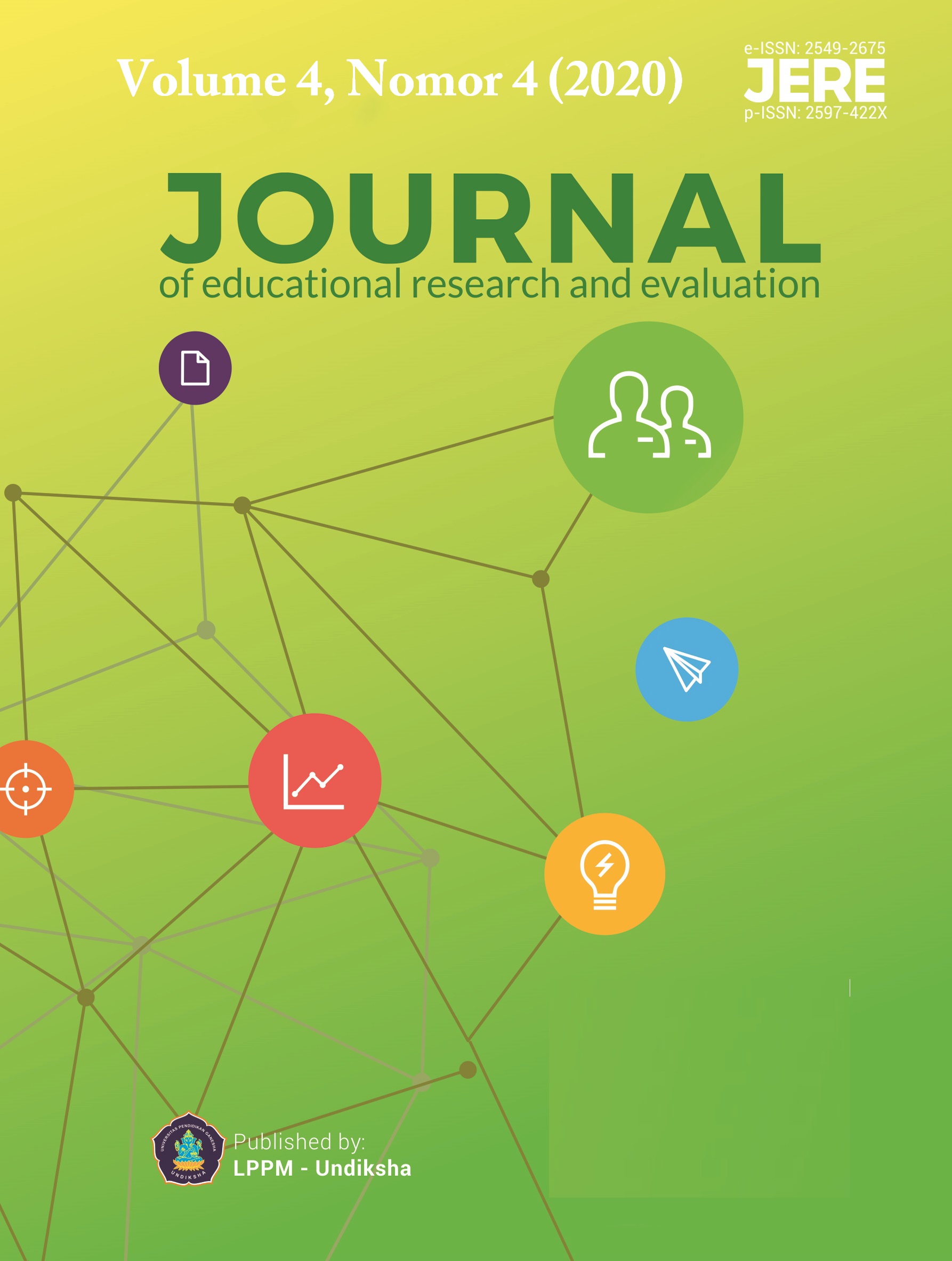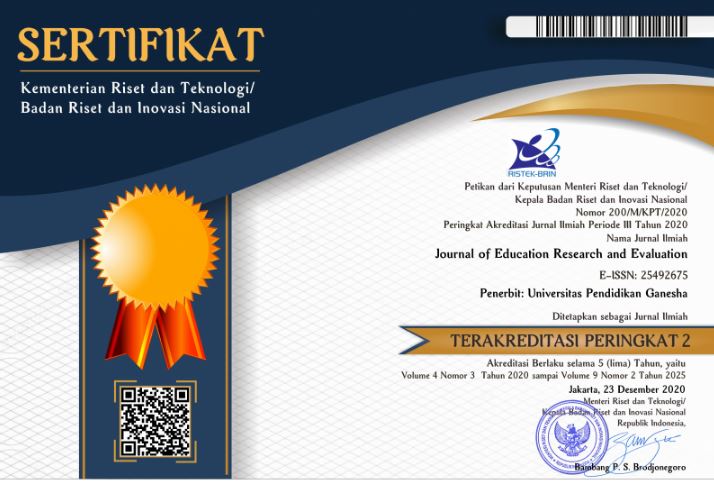Utilization of E-Learning-Based ICT Learning Using the Google Classroom Application During the COVID-19 Pandemic
DOI:
https://doi.org/10.23887/jere.v4i4.29181Keywords:
E-Learning, Google Classroom, Covid-19.Abstract
The impact of the Covid-19 pandemic has brought changes to the learning process, from face-to-face at school to online distance learning called e-learning. The research objective is to describe the implementation of e-learning-based ICT learning using the Google Classroom application during the Covid-19 pandemic in public high schools. The research used a qualitative approach and was conducted on class X MIA students. 1. Data collection was carried out by observation, interviews, and documentation study. Data analysis was carried out, namely data reduction, data presentation, and concluding. The results showed that the use of the google classroom application made the ICT learning process easier during the covid-19 period. The advantages of the google classroom application as a learning medium are: (1) it has flexibility in terms of time and place; (2) the application is easy to understand and operate; (3) The use of applications is effective and efficient; (4) the learning evaluation process is more accurate. This research concludes that the google classroom application facilitates the ICT learning process during the covid-19 period.
References
Al-Maroof, RAS, & Al-Emran, M. (2018). Students acceptance of google classroom: An exploratory study using PLS-SEM approach. International Journal of Emerging Technologies in Learning, 13(6), 112–123. https://doi.org/10.3991/ijet.v13i06.8275
Alqudah, NM, Jammal, HM, Saleh, O., Khader, Y., Obeidat, N., & Alqudah, J. (2020). Perception and experience of academic Jordanian ophthalmologists with E-Learning for undergraduate course during the COVID-19 pandemic. Annals of Medicine and Surgery, 59(June), 44–47. https://doi.org/10.1016/j.amsu.2020.09.014
Anderson, J. (2005). IT, e-learning and teacher development. International Education Journal, 5(5), 1-14.
Anshari, M., Almunawar, M. N., Shahrill, M., Wicaksono, D. K., & Huda, M. (2017). Smartphones usage in the classrooms: Learning aid or interference?. Education and Information Technologies, 22(6), 3063-3079
Baiyere, A., & Li, H. (2016) ‘Application of a virtual collaborative environment in a teaching case’. In AMCIS 2016: Surfing the IT Innovation Wave - 22nd Americas Conference on Information Systems
Bhimani, NT (2020). Google Classroom platform for Physiology teaching in Medical College. 3, 295–303.
Dewi, N., Zahrovi, E., & Sulistyawati, MES (2020). The Implementation Of Google Classroom In Improving Students 'Reading Comprehension At Man 4 Jakarta. Lingual: Journal of Language and Culture, 9(1), 21. https://doi.org/10.24843/ljlc.2020.v09.i01.p04
Hakim, A.B., (2016). Efektifitas Penggunaan E-Learning Moodle, Google Classroom Dan Edmodo. I-STATEMENT: Information System and Technology Management, 2(1).
Hamid, MA (2016). Development of ICT-Based Student Learning Outcomes Assessment Instruments in Basic Electrical Electronics Learning. VOLT: Scientific Journal of Electrical Engineering Education, 1, 37–46. https://doi.org/http://dx.doi.org/10.30870/volt.v1i1.822
Hardjana, Agus M. (2003). Komunikasi Intrapersonal dan Interpersonal, Yogyakarta : Kanisius
Iftakhar, Shampa. "Google classroom: what works and how?." Journal of Education and Social Sciences 3 (2016): 12-18.
Izenstark, A., & Leahy, K. L. (2015). Google classroom for librarians: features and opportunities. Library Hi Tech News, 32(9), 1-3.
Jaya Komar C. Koran. Aplikasi e Learning dalam pengajaran dan pembelajaran di sekolah–sekolah Malaysia: Cadangan pelaksanaan pada senario masa kini, pasukan projek rintis sekolah bestari bahagian teknologi pendidikan, Kementerian pendidikan malaysia
Kristinawati, E., Susilo, H., & Gofur, A. (2018). ICT Based-Problem Based Learning on Students' Cognitive Learning Outcomes. Journal of Science Education, 6(2), 38–42. https://doi.org/http://dx.doi.org/10.17977/jps.v6i2.11683
Martínez-Monés, A., Reffay, C., Torío, J. H., & Cristóbal, J. A. M. (2017, October). Learning Analytics with Google
Classroom: Exploring the possibilities. In Proceedings of the 5th International Conference on Technological
Ecosystems for Enhancing Multiculturality (p. 47). ACM
Liu, H. C., & Chuang, H. H. (2016). Integrating Google Classroom to Teach Writing in Taiwan. Minnesota eLearning Summit.
Mayer, RE (2019). Searching for the role of emotions in e-learning. Learning and Instruction, May, 101213. https://doi.org/10.1016/j.learninstruc.2019.05.010
Miarso, Y., (2004). Menyemai benih teknologi pendidikan, Kencana. Smaldino, S.E., Lowther, D.L. & Russell, J.D., (2008). Instructional technology and media for learning.
Pramono, F., Didi Rosiyadi, & Windu Gata. (2019). Integration of N-gram, Information Gain, Particle Swarm Optimization on Naïve Bayes for Optimization of Google Classroom Sentiment. Journal of RESTI (Systems Engineering and Information Technology), 3(3), 383–388. https://doi.org/10.29207/resti.v3i3.1119
Remuzzi, A., & Remuzzi, G. (2020). COVID-19 and Italy: What next? Lancet, 395, 1225–1228. 10.1016/S0140-6736(20)30627-9.
Romi Satria Wahono. Meluruskan Salah Kaprah Tentang E-Learning. http://romisatriawahono.net/2008/01/23/meluruskan-salahkaprah-tentang-e-learning/. diakses tanggal 24 Juli 2014
Roni Hamdani, A., & Priatna, A. (2020). The Effectiveness of the Implementation of Online Learning (Full Online) during the Covid-19 Pandemic at the Elementary School Level in Subang Regency. Didactic: Scientific Journal of PGSD STKIP Subang, 6(1), 1–9. https://doi.org/10.36989/didaktik.v6i1.120
Sadikin, A., & Hamidah, A. (2020). Online Learning Amid the Covid-19 Outbreak. Biodics, 6(2), 109–119. https://doi.org/10.22437/bio.v6i2.9759
Setiawan, D., & Wicaksono, SL (2020). Google Classroom Usability Evaluation Using System Usability Scale. Walisongo Journal of Information Technology, 2(1), 71. https://doi.org/10.21580/wjit.2020.2.1.5792
Sukmawati, S., & Nensia, N. (2019). The Role of Google Classroom in ELT. International Journal for Educational and Vocational Studies, 1(2), 142–145. https://doi.org/10.29103/ijevs.v1i2.1526
Waksena. E- Learning Ilmu Pendidikan. http://elearningpendidikan.com/e-learning-ilmu-pendidikan.html. diakses tanggal 22 Juli 2014
Wijaya, A. (2016, February). Analysis of Factors Affecting the Use of Google Classroom to Support Lectures. In The 5th International Conference on Information Technology and Engineering Application (ICIBA2016). Bina Darma University.
Yaumi, M. (2012). Development of English Teaching Materials for Specific Purpose Based on Tick. Lentera Pendidikan: Journal of Tarbiyah and Teacher Training, 15(2), 144–160. https://doi.org/10.24252/lp.2012v15n2a2
Downloads
Published
How to Cite
Issue
Section
License
Authors who publish with the Journal of Evaluation and Research in Education (JERE) agree to the following terms:
- Authors retain copyright and grant the journal the right of first publication with the work simultaneously licensed under a Creative Commons Attribution License (CC BY-SA 4.0) that allows others to share the work with an acknowledgment of the work's authorship and initial publication in this journal.
- Authors are able to enter into separate, additional contractual arrangements for the non-exclusive distribution of the journal's published version of the work (e.g., post it to an institutional repository or publish it in a book), with an acknowledgment of its initial publication in this journal.
- Authors are permitted and encouraged to post their work online (e.g., in institutional repositories or on their website) prior to and during the submission process, as it can lead to productive exchanges, as well as earlier and greater citation of published work. (See The Effect of Open Access)











